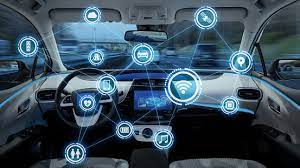Telematics: The next frontier of trucking
Automotive companies are integrating telematics to monitor vehicle performance and ensure vehicle and passenger security
The biggest developments in technology have probably been in communications, and trucking is no exception. The way trucks and drivers manage their fleet is undergoing a sea change, and it is only going to scale up further in the years to come.
 Until recently, infrastructure investment and lack of customer demand sidelined telematics from the broader picture. With mobile technology and smart phones inbuilt internet and GPS facilities having penetrated the length and breadth of India, telematics revolution is gradually making its presence felt. The ease of collecting vehicle and driver data on the phone, is proving to be a game-changer for fleet management. And this has been possible only through telematics technology and the usefulness of this system. In the last few years, vehicle telematics has revolutionized the whole scenario of fleet transport with a new set of innovations. It is shaping the future of the trucking industry, taking efficiencies and hence, profitability to new levels. The benefits are multifold. It allows constant access to the truck, including monitoring vehicle location and also travel duration. This wireless communication has also made it possible for fleet owners and also drivers to deliver better performance. It takes the estimate and guesswork out of the situation through constant two-way communication. It delivers information to optimize vehicle utilization. Telematics technology improves maintenance and repairs, alerting owners when the service is due. It also improves communication and navigation and hence, fuel efficiencies. Fuel savings have been found to increase. All this data is valuable to fleets as it helps with reduced downtime.
Until recently, infrastructure investment and lack of customer demand sidelined telematics from the broader picture. With mobile technology and smart phones inbuilt internet and GPS facilities having penetrated the length and breadth of India, telematics revolution is gradually making its presence felt. The ease of collecting vehicle and driver data on the phone, is proving to be a game-changer for fleet management. And this has been possible only through telematics technology and the usefulness of this system. In the last few years, vehicle telematics has revolutionized the whole scenario of fleet transport with a new set of innovations. It is shaping the future of the trucking industry, taking efficiencies and hence, profitability to new levels. The benefits are multifold. It allows constant access to the truck, including monitoring vehicle location and also travel duration. This wireless communication has also made it possible for fleet owners and also drivers to deliver better performance. It takes the estimate and guesswork out of the situation through constant two-way communication. It delivers information to optimize vehicle utilization. Telematics technology improves maintenance and repairs, alerting owners when the service is due. It also improves communication and navigation and hence, fuel efficiencies. Fuel savings have been found to increase. All this data is valuable to fleets as it helps with reduced downtime.
The Road Ahead
Telematics is a becoming an important aspect of the industry and it could soon become the standard norm / default setting for heavy trucks. It is important not only for the health and performance of the trucks, but also ensuring well-being and efficiencies of the business.
This disruptive wireless communication is a fast growing segment. According to a study, the telematics market is estimated to be worth $39 billion, and is expected to grow at 18% rate by 2022. Major chunk of this pie is going to be dominated by commercial vehicles. And countries like India and China, which are large CV markets, will drive this growth. India, is actually one of the fastest growing telematics markets and the installations in CV is expected to grow to 9.3% in 2023 ( from 2.4 % in 2016) as per a research conducted by Frost and Sullivan.
One of the biggest benefits is also towards safety on the road. These analytics help fleet owners keep track and get insights on driver behaviour and performance. Any damage or loss of trucks due to accidents and thefts are also alerted to the owner.
The growth of telematics, globally, has been in the logistics and supply chain segment in domains such as- information, navigation, safety, and remote diagnostics. Automotive companies have integrated telematics to monitor vehicle performance and ensure vehicle and passenger security.
The India Scenario:
In India, the main drivers of the commercial vehicle telematics market have been increasing fuel prices that have compelled the fleet operators to opt for telematics. Telematics offers fleet management solutions which will play a significant role in reducing fuel costs by cutting down empty runs, thereby reducing overall vehicle downtime. Other factors that influence the demand of vehicle telematics are the safety and security issues. Road safety and proper traffic management is a huge concern in India and telematics offers efficient solutions in this sphere – such as thorough driver risk assessment technology and driver ratings. Analysis of real-life driving behavior, driving patterns, live alerts and warnings can be produced in case of any violation of safe driving practices, such as over speeding, hurried braking, seat-belt use, indicator use, checking blind spots, engine revving, wrong gear selection and rash acceleration.
Telematics transmits real time data generated by the vehicle to the back-end server which is then converted to meaningful information and reports. This data can be fuel related, distance travelled, error codes, driving pattern etc. Integration of telematics can convert a normal vehicle into an intelligent version with a few cutting-edge features such as fuel management, GPS navigation, vehicle tracking, automatic driving assistance systems support, triggering alerts in case of unauthorized interference, remote service support, SOS transmission of diagnostics information during emergency and other related features.CV manufacturers in India have over a period of time also started to realize that telematics is not just about monitoring, but also about achieving transparency in business processes and efficiency. Remote diagnosis & assistance can help owners in getting improved uptime/turn-around time, while CV manufacturers will benefit by reduced warranty costs through preventive actions, and enhanced customer satisfaction.
Eicher has pioneered the use of intelligent technologies in trucks and tippers to bring a significant improvement in quality, efficiency and productivity operations. Eicher is one of the first players to introduce the Fuel Coaching system in their Pro Series trucks which enables the driver to improve his driving and achieve better fuel efficiency. Eicher Live, a telematics enabled advanced fleet management is a “Live Hub” of real-time communication and actions by customers, dealers and Eicher. It allows the management of truck fleets by monitoring their movement, fuel consumption and maintenance needs. It enables proactive maintenance of the truck. Eicher Live offers granular views at the level of a driver, a vehicle and a time span. It’s a real time dashboard of the fleet, tracking the most important factors. Together with the fully equipped Eicher service network, this ensures preventive and corrective maintenance of the truck, thus delivering superior uptime.
Telematics does play a crucial role for commercial fleet operators as it will also make legal process more hassle-free as there would be more chances of the said events being recorded in the form of images or electronics transmissions. It also helps in lowering the vehicle insurance premium. For instance, telematics in vehicles tracks vehicular thefts. Current technologies available are expected to prevent theft of vehicles but very few have solutions that can report theft automatically. This can be done by a vehicle telematics solution. Also, the use of telematics will lower accident probability, leading to reduced insurance premium. Some leading FIs in India (e.g. ICICI) have already started evaluating the telematics factor in deciding insurance premium.
A tool for driver engagement
Drivers’ community is an important and critical element of CV industry and telematics can help to achieve greater harmony between drivers and owners by increased drivers’ engagement, reliable data for performance based incentives, and enabling safety and infotainment needs of driver. The increasing penetration of affordable smart mobile devices is also helping in increasing telematics’ reach as the service providers are integrating the offering on mobile platforms for providing information and data on the move.
India still has a long way to go in adoption of vehicle telematics. While India is a fast growing market, what is seen as a hurdle is the high cost involved in telematics. Another challenge occurs from the low range utilization of telematics technologies and technical unawareness among consumers. However, the application of telematics and data analytics in the logistics space presents a massive opportunity for higher revenues and operational profits for fleet operators. As competition intensifies, advanced telematics will be a key enabler for sustainability in trucking, and a business imperative to maintain a competitive edge. The coming years will witness the rise of the connected ecosystem, which will be enable fleet operators and external stakeholders such as governments, insurance companies etc., for efficient operations.



